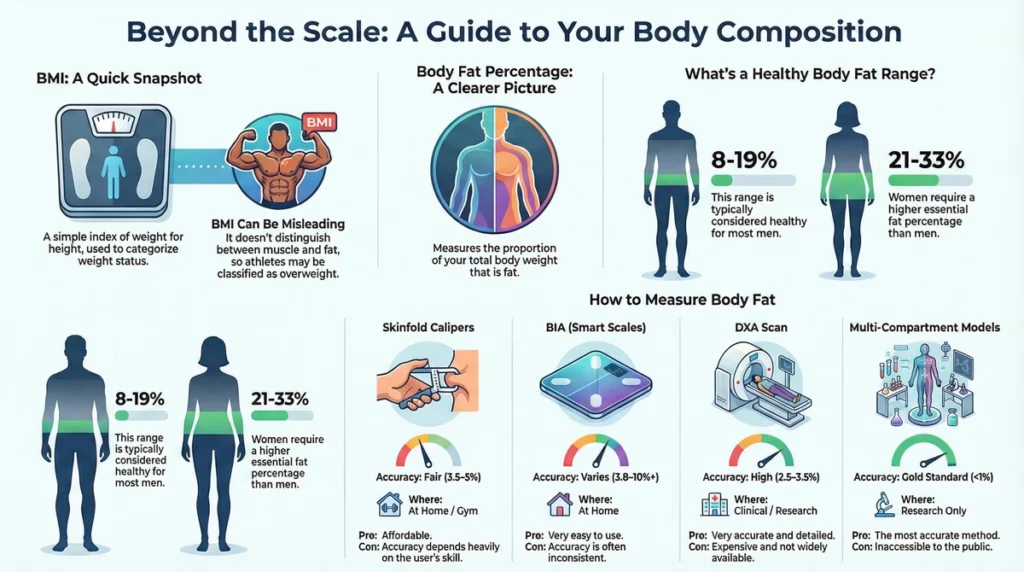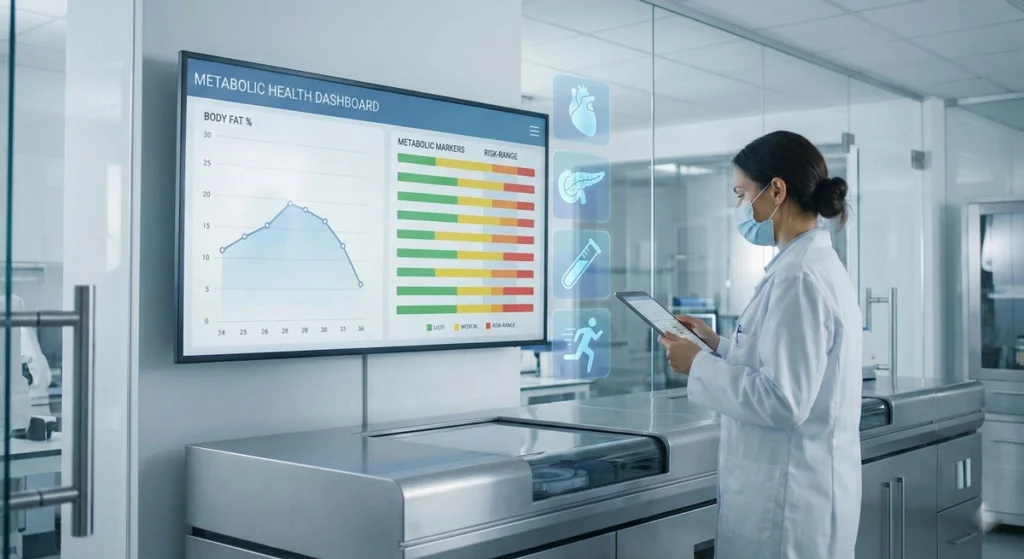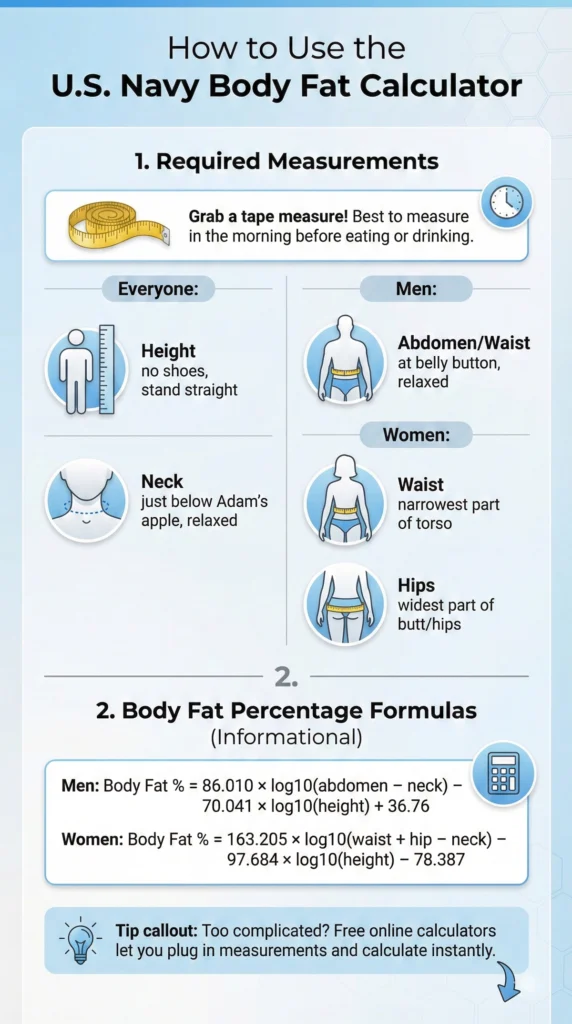Ever stepped on the scale and felt completely deflated despite all your hard work at the gym? Trust me, I’ve been there! What if I told you that your trusty bathroom scale might be leading you astray? Welcome to the world of body fat percentage (BFP) – the measurement that actually matters when it comes to understanding your health and fitness. Today, I’m diving deep into everything you need to know about using a body fat index calculator and why it’s so much more valuable than just checking your weight.
- Understanding Body Composition: Why BFP Surpasses BMI
- Comparative Analysis of Body Fat Measurement Methods
- New Body Fat Thresholds for Obesity Risk (Metabolic Health)
- Practical Application: How to Use the U.S. Navy Body Fat Calculator
- Strategies for Reducing and Managing Body Fat
- Conclusion: Moving Towards BFP-Centric Health Management
Understanding Body Composition: Why BFP Surpasses BMI

Let’s get real for a second – your body is way more complex than just a number on the scale! Body fat percentage (%BF) tells you how much of your body is made up of fat compared to everything else (muscle, bones, organs, etc.). This gives you a much clearer picture of your health than just knowing how much gravity pulls on you.
The Fundamental Flaw of BMI as an Obesity Indicator
We’ve all heard about BMI (Body Mass Index), right? It’s that simple formula where you divide your weight by your height squared. Doctors have been using it forever, and it’s super easy to calculate, but here’s the thing – it’s kind of like using a flip phone in the age of smartphones!
BMI has some serious limitations:
- It can’t tell the difference between muscle and fat. So my buddy Mike who’s a personal trainer? According to BMI, he’s “obese” despite having visible abs! 🤦♂️
- Then there’s my aunt who looks thin but gets winded walking up stairs – her BMI says she’s “normal” but she actually has too much fat and not enough muscle (what doctors call “skinny fat” or more technically “metabolically obese normal weight”).
- If you’re pregnant, an athlete, or have certain medical conditions, BMI is about as useful as a chocolate teapot.
The Importance of Accurate Adiposity Assessment
Here’s where things get serious – carrying too much body fat isn’t just about how you look in swimwear. Excess fat (especially around your middle) is linked to some pretty scary health issues like Type 2 diabetes, heart disease, stroke, certain cancers, and sleep apnea.
That’s why knowing your body fat index versus just calculating your body mass index body fat comparison is so important. Even the World Health Organization defines obesity based on having excessive fat, not just being heavy!
Comparative Analysis of Body Fat Measurement Methods
So how do I calculate my body fat index accurately? Good question! There’s actually no single “perfect” method that works for everyone. Let me break down your options:
The Gold Standards
DXA (Dual-Energy X-ray Absorptiometry): This is the fancy schmancy option that works kind of like an X-ray for your fat. Super accurate and can even tell you where your fat is distributed. Downside? It’s expensive, requires specialized equipment, and if you’re on the larger side, you might not even fit in the machine.
Underwater Weighing: Remember Archimedes jumping out of his bathtub yelling “Eureka”? This method uses similar principles. You get dunked underwater to measure your density. It’s super accurate but try getting your grandma to fully submerge herself while breathing all the air out of her lungs. Not happening!
CT Scans & MRI: These give incredibly detailed images of your fat distribution. They’re amazing for research but involve either radiation exposure (CT) or expensive, limited-access equipment (MRI). Plus, larger folks might not fit in these machines either.
The Practical Options
U.S. Navy Circumference Method: This is my personal favorite for everyday use! All you need is a tape measure and a calculator. It’s surprisingly accurate (within 3-4% of the fancy methods) and takes just minutes. I’ll show you exactly how to do this later.
Bioelectrical Impedance (BIA): Those bathroom scales that claim to measure your body fat? They work by sending a tiny electrical current through your body. Water conducts electricity, fat doesn’t – so they estimate how much fat you have based on resistance. They can be off by as much as 10% though, especially if you’re dehydrated, just worked out, or had a couple of drinks last night.
New Body Fat Thresholds for Obesity Risk (Metabolic Health)

So what should your body fat index actually be? Good news – recent research has given us some concrete numbers based on actual health risks, not just aesthetics!
Proposed Clinically Relevant %BF Thresholds
Researchers analyzed DXA data from a huge sample of the US population and figured out the body fat levels where people start developing metabolic syndrome (a cluster of conditions that increase your risk of heart disease, stroke, and diabetes):
- Men: You’re entering the danger zone at 25% body fat and definitely at risk at 30%
- Women: Your caution levels begin at 36% body fat and high risk at 42%
These numbers are based on actual health outcomes, not just appearance!
Standard Body Fat Percentage Ranges
For those more concerned with fitness than just avoiding disease, here are the standard ranges fitness professionals use:
For Men:
- Essential fat: 2-5% (Think professional bodybuilders on competition day – not sustainable!)
- Athletes: 6-13% (Your typical CrossFit competitor or marathon runner)
- Fitness: 14-17% (Regular gym-goer with visible muscle definition)
- Average: 18-24% (Healthy, but not particularly athletic)
- Obese: 25%+ (Increased health risks start here)
For Women:
- Essential fat: 10-13% (Women need more essential fat for hormonal functions)
- Athletes: 14-20% (Female pro athletes and fitness competitors)
- Fitness: 21-24% (Regular exerciser with good muscle tone)
- Average: 25-31% (Healthy range for most women)
- Obese: 32%+ (Health risks increase beyond this point)
Women naturally carry more body fat than men – it’s completely normal and necessary for reproductive health!
Practical Application: How to Use the U.S. Navy Body Fat Calculator
Ready to find out your body fat percentage without expensive equipment? The U.S. Navy method is your new best friend! It’s quick, easy, and surprisingly accurate.
Required Measurements for the U.S. Navy Method
Grab a flexible tape measure and let’s get started! For best results, measure in the morning before eating or drinking.
Everyone needs:
- Height: Stand straight against a wall, no shoes!
- Neck: Measure just below your Adam’s apple (or where it would be for women), with the tape slightly sloping downward to the front. Don’t flex your neck muscles!
Men also need:
- Waist/Abdomen: Measure right at your belly button, relaxed (no sucking in!)
Women also need:
- Waist: Measure at the narrowest part of your torso
- Hips: Measure at the widest part of your butt/hips
U.S. Navy Body Fat Percentage Formulas
Now for the math (don’t worry, online calculators do this for you!):
For Men: Body Fat % = 86.010 × log10(abdomen – neck) – 70.041 × log10(height) + 36.76
For Women: Body Fat % = 163.205 × log10(waist + hip – neck) – 97.684 × log10(height) – 78.387
Too complicated? Just Google “body fat index calculator navy method” and you’ll find plenty of free calculators online where you just plug in your measurements.

Strategies for Reducing and Managing Body Fat
Knowing your numbers is just step one. What do you do if you want to lower your body fat percentage? I’ve got you covered!
Key Lifestyle Changes for Fat Reduction
- Smarter Eating: Notice I didn’t say “diet” – because this isn’t about deprivation! Focus on whole foods like vegetables, lean proteins, and healthy fats. Swap processed snacks for fruits, nuts, or Greek yogurt. Creating a moderate calorie deficit (eating slightly less than you burn) is key, but quality matters more than just counting calories.
- Exercise That Works: You can’t out-train a bad diet, but the right exercise strategy makes a huge difference! Aim for:
- Strength training 2-3 times per week (builds metabolism-boosting muscle)
- Some form of cardio 3-5 times per week (burns calories and improves heart health)
- Try HIIT (High-Intensity Interval Training) if you’re short on time – it’s super effective for fat loss!
- Sleep and Hydration: The unsung heroes of fat loss! When you’re sleep-deprived, your body produces more hunger hormones. Aim for 7-9 hours of quality sleep. And water? It boosts your metabolism, helps control hunger, and keeps your workouts strong. Carry a water bottle everywhere!
Frequently Asked Questions
How accurate is a typical online body fat calculator?
Most online calculators using the U.S. Navy method are within 3-4% of laboratory methods – not perfect, but definitely good enough for tracking your progress! The key is consistency – always measure at the same time of day, preferably in the morning before eating, and use the same calculator.
What is the most accurate method for measuring body fat percentage?
DEXA scans are currently considered the gold standard. They use low-dose X-rays to precisely measure fat, muscle, and bone density throughout your body. If you’re really serious about accuracy and don’t mind spending $75-200 per scan, many sports medicine clinics and some fitness centers offer this service.
Can I accurately track fat loss using BMI?
Sorry, but no! If you’re working out regularly, you might be building muscle while losing fat – meaning your weight (and BMI) might stay exactly the same while your body composition improves dramatically. This is why focusing only on the scale can be so frustrating! Your body fat index tells the real story.
Why is hydration status important for body fat measurement?
If you’re using bioelectrical impedance scales (like most home bathroom scales that measure body fat), being dehydrated can make your body fat reading artificially high. Conversely, being over-hydrated can make it artificially low. For most consistent results, measure first thing in the morning after using the bathroom but before eating or drinking.
Conclusion: Moving Towards BFP-Centric Health Management
The scale is just one tool – and honestly, not even the most useful one! By focusing on your body fat percentage instead of just your weight, you’ll get a much clearer picture of your actual health risks and fitness progress.
The good news? You don’t need expensive equipment to track this. The U.S. Navy method gives you a practical way to monitor your body composition at home with just a tape measure. For most of us, aiming for the “Fitness” or healthy “Average” ranges is perfectly reasonable – you don’t need to look like a fitness model to be healthy!
Remember that small, consistent changes yield the best long-term results. Focus on building healthy habits around eating, exercise, sleep, and stress management, rather than extreme approaches that aren’t sustainable.
Disclaimer: This article is for informational purposes only and is not intended as medical advice. Always consult with a healthcare professional before beginning any new fitness or nutrition program, especially if you have existing health conditions.